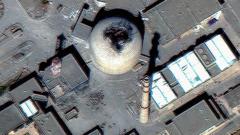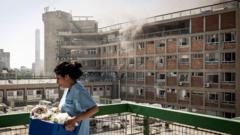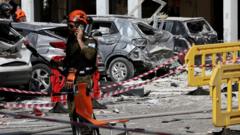Amid ongoing conflict, Israeli airstrikes aimed at halting Iran's nuclear capabilities have led to international concerns regarding escalation and potential repercussions.
**Israel Launches Airstrikes on Arak Heavy Water Reactor in Iran**

**Israel Launches Airstrikes on Arak Heavy Water Reactor in Iran**
In a significant escalation of hostilities, Israeli forces targeted Iran's unfinished nuclear reactor as part of a broader military campaign.
Israeli fighter jets have executed a strategic bombing raid on the Arak heavy water reactor under construction in central Iran, marking the seventh day of intensified military conflict between the two nations. The Israel Defense Forces confirmed the targeted strike on the reactor's core seal, asserting it aimed to thwart any potential development of nuclear weapons by Iran. The International Atomic Energy Agency (IAEA) has verified that the reactor, which was under renovation, contained no nuclear material at the time of the strike.
The Arak facility, intended for peaceful nuclear energy purposes according to Iranian government claims, has been the subject of previous international agreements, notably a 2015 accord where Iran pledged to redesign the reactor to eliminate its capability to produce weapons-grade plutonium. This modulation effort entailed removing the reactor's calandria, rendering it inoperative until further construction could occur, with Iran indicating expectations for operational capability by 2026.
Recent Israeli military communications accused Iranian officials of intentionally stalling alterations to the reactor, allegedly to pressure Western nations. Following the airstrike, footage released displayed significant damage, including a gaping hole in the domed roof of the reactor and visible destruction of nearby facilities. Iranian state media reported that the site had been fortified against potential attacks and claimed that the airstrike did not result in nuclear contamination.
Israeli forces have intensified their operations, recently targeting the Natanz facility, a crucial site for uranium enrichment vital to nuclear fuel and possibly weaponized applications. Reports indicate the destruction of vital infrastructure and equipment, with the IAEA monitoring the situation closely.
The ongoing hostilities have resulted in substantial casualties, with Iranian authorities reporting at least 224 fatalities, while external assessments suggest numbers may be higher. In retaliation, Iran has launched counter-offensive strikes, leading to additional losses and escalating tensions in the region. As the situation develops, global concern mounts over the implications of these military actions on international relations and nuclear non-proliferation.
The Arak facility, intended for peaceful nuclear energy purposes according to Iranian government claims, has been the subject of previous international agreements, notably a 2015 accord where Iran pledged to redesign the reactor to eliminate its capability to produce weapons-grade plutonium. This modulation effort entailed removing the reactor's calandria, rendering it inoperative until further construction could occur, with Iran indicating expectations for operational capability by 2026.
Recent Israeli military communications accused Iranian officials of intentionally stalling alterations to the reactor, allegedly to pressure Western nations. Following the airstrike, footage released displayed significant damage, including a gaping hole in the domed roof of the reactor and visible destruction of nearby facilities. Iranian state media reported that the site had been fortified against potential attacks and claimed that the airstrike did not result in nuclear contamination.
Israeli forces have intensified their operations, recently targeting the Natanz facility, a crucial site for uranium enrichment vital to nuclear fuel and possibly weaponized applications. Reports indicate the destruction of vital infrastructure and equipment, with the IAEA monitoring the situation closely.
The ongoing hostilities have resulted in substantial casualties, with Iranian authorities reporting at least 224 fatalities, while external assessments suggest numbers may be higher. In retaliation, Iran has launched counter-offensive strikes, leading to additional losses and escalating tensions in the region. As the situation develops, global concern mounts over the implications of these military actions on international relations and nuclear non-proliferation.



















